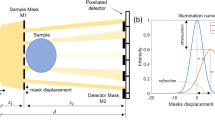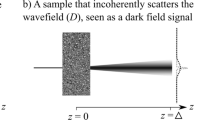Abstract
Spatial resolution and image-processing methods for full-field X-ray fluorescence (FF-XRF) imaging using X-ray pinhole cameras were studied using Geant4 simulations with different geometries and algorithms for image reconstruction. The main objectives were: (1) calculating the quantum efficiency curves of specific cameras, (2) studying the relationships between the spatial resolution and the pinhole diameter, magnification, and camera binning value, and (3) comparing image-processing methods for pinhole camera systems. Several results were obtained using a point and plane source as the X-ray fluorescence emitter and an array of 100 × 100 silicon pixel detectors as the X-ray camera. The quantum efficiency of a back-illuminated deep depletion (BI-DD) structure was above 30% for the XRF energies in the 0.8–9 keV range, with the maximum of 93.7% at 4 keV. The best spatial resolution of the pinhole camera was 24.7 μm and 31.3 lp/mm when measured using the profile function of the point source, with the diameter of 20 μm, magnification of 3.16, and camera bin of 1. A blind deconvolution algorithm with Gaussian filtering performed better than the Wiener filter and Richardson iterative methods on FF-XRF images, with the signal-to-noise ratio of 7.81 dB and improved signal-to-noise ratio of 7.24 dB at the diameter of 120 μm, magnification of 1.0, and camera bin of 1.














Similar content being viewed by others
References
M.G. Vasin, Y.V. Ignatiev, A.E. Lakhtikov et al., Energy-resolved X-ray imaging. Spectrochimica Acta Part B. 62, 648–653 (2007). https://doi.org/10.1016/j.sab.2007.05.011
P. Walter, P. Sarrazin, M. Gailhanou et al., Full-field XRF instrument for cultural heritage: application to the study of a Caillebotte painting. X-Ray Spectrom. 48, 274–281 (2018). https://doi.org/10.1002/xrs.2841
A. Kulow, A.G. Buzanich, U. Reinholz, F. Emmerling, S. Hampel, U.E.A. Fittschen, M. Radtke, Comparison of three reconstruction methods based on deconvolution, iterative algorithm and neural network for X-ray fluorescence imaging with coded aperture optics. J. Anal. At. Spectrom. 35(7), 1423–1434 (2020)
F.P. Romano, C. Altana, L. Cosentino et al., A new X-ray pinhole camera for energy dispersive X-ray fluorescence imaging with high-energy and high-spatial resolution. Spectrochimica Acta Part B. 86, 60–65 (2013). https://doi.org/10.1016/j.sab.2013.04.012
I. Ordavo, S. Ihle, V. Arkadiev et al., A new pnCCD-based color X-ray camera for fast spatial and energy-resolved measurements. Nucl. Instrum. Meth. Phys. Res. A 654, 250–257 (2011). https://doi.org/10.1016/j.nima.2011.05.080
W. Zhao, K. Sakurai, Seeing elements by visible-light digital camera. Sci. Rep. 7, 45472 (2017). https://doi.org/10.1038/srep45472
J. Žemlička, J. Jakůbek, M. Kroupa et al., Energy- and position-sensitive pixel detector timepix for X-ray fluorescence imaging. Nucl. Instrum. Meth. Phys. Res. A 607, 202–204 (2009). https://doi.org/10.1016/j.nima.2009.03.140
F.P. Romano, C. Caliri, L. Cosentino et al., Macro and micro full field x-ray fluorescence with an X-ray pinhole camera presenting high energy and high spatial resolution. Anal. Chem. 86, 10892–10899 (2014). https://doi.org/10.1021/ac503263h
A. Vella, A.A.M. Munoz, M.J.F. Healy et al., An artificial X-ray wire test emitter and calculations on the resolution and field of view of X-ray pinhole optics by simulation. Nucl. Instrum. Meth. Phys. Res. A 905, 119–128 (2018). https://doi.org/10.1016/j.nima.2018.07.049
W. Zhao, K. Sakurai, CCD camera as feasible large-area-size x-ray detector for x-ray fluorescence spectroscopy and imaging. Rev. Sci. Instrum. 88, 063703 (2017). https://doi.org/10.1063/1.4985149
G. **ong, W. Jia, Q. Shan et al., Equipment design and performance characterization of full field x-ray fluorescence (FF-XRF) element distribution imaging system with combined collimating lens (CCL). Rev. Sci. Instrum. 91, 123701 (2020). https://doi.org/10.1063/5.0024461
H. **e, B. Deng, G. Du et al., Methodology development and application of X-ray imaging beamline at SSRF. Nucl. Sci. Tech. 31, 102 (2020). https://doi.org/10.1007/s41365-020-00805-7
J. Zhang, Q. Yi, L. Li et al., simulation and experimental study of the angle-dependent sensitivity of the thick pinhole used for gamma imaging. Nucl. Instrum. Methods Phys. Res. A 915, 24–30 (2019). https://doi.org/10.1016/j.nima.2018.10.163
Z.M. Yao, B.J. Deng, J.M. Mang et al., Numerical simulation of large thick aperture imaging. Ato. Energy Sci. Technol. 53, 379–384 (2019). https://doi.org/10.7538/yzk.2018.youxian.0294(inChinese)
S.F. Sun, X.P. Ouyang, A feasibility study on the application of separable coded masks to X-ray fluorescence imaging. J. Anal. At. Spectrum 36, 210–223 (2021). https://doi.org/10.1039/d0ja00413h
Z. He, N. Huang, P. Wang et al., Simulation study of full-field X-Ray fluorescence imaging with a pinhole camera. High Power Laser and Particle Beams. 33, 1–9 (2021)
M. Shen, Experimental image of pinhole using CdZnTe detector. In Appl. Mech. Mater. 321, 935–939 (2013)
H. Chen, M. Gu, X. Liu et al., Effect of CsI(Tl) micro-conical-frustums on the performance of the pixelated CsI(Tl) scintillation screen in X-ray imaging. Nucl. Instrum. Methods Phys. Res. A 921, 18–21 (2019). https://doi.org/10.1109/tns.2006.869826
Oxford Instruments Andor, Newton-SY CCD camera overviews. https://andor.oxinst.cn/products/high-energy-detection/newton-sy [accessed on 10 April 2021]
J. Allison, K. Amako, J. Apostolakis et al., Geant4 developments and applications. IEEE Trans. Nucl. Sci. 53, 270–278 (2006). https://doi.org/10.1016/j.nima.2007.06.005
P.M. Wróbel, T. Fiutowski, S. Koperny et al., Modelling of vignetting refer in full-field X-ray fluorescence imaging system based on pinhole optics. Spectrochimica Acta Part B. 171, 105934 (2020). https://doi.org/10.1016/j.sab.2020.105934
A.D. Hillery, R.T. Chin, Iterative Wiener filters for image restoration. IEEE Trans. Signal Process. 39, 1892–1899 (1991). https://doi.org/10.1109/78.91161
W.H. Richardson, Bayesian-based iterative method of image restoration. J. Opt. Soc. Am. 62, 55–59 (1972). https://doi.org/10.1364/JOSA.62.000055
R.C. Gonzalez, R.E. Woods, Digital Image Processing, 4th edn. (Pearson, New York, 2018), pp. 352–356
D.S.C. Biggs, A. Andrews, Acceleration of iteration image restoration algorithms. Appl. Opt. 36, 1766–1775 (1997). https://doi.org/10.1364/AO.36.001766
F.P. Romano, C. Caliri, L. Cosentino et al., Micro X-ray fluorescence imaging in a tabletop full field-X-ray fluorescence instrument and in a full field-particle induced X-ray emission end station. Anal. Chem. 88, 9873–9880 (2016). https://doi.org/10.1021/acs.analchem.6b02811
Acknowledgements
We would also like to acknowledge Prof. Zhu An for his valuable suggestions on this paper.
Author information
Authors and Affiliations
Contributions
All authors contributed to the study conception and design. Material preparation, data collection, and analysis were performed by Ze He, Ning Huang, Peng Wang, Zihan Chen, and Bo Peng. The first draft of the manuscript was written by Ze He, and all authors commented on previous versions of the manuscript. All authors read and approved the final manuscript.
Additional information
This work was supported by the Sichuan Science and Technology Program, China (No. 2020ZDZX0004).
Rights and permissions
About this article
Cite this article
He, Z., Huang, N., Wang, P. et al. Spatial resolution and image processing for pinhole camera-based X-ray fluorescence imaging: a simulation study. NUCL SCI TECH 33, 64 (2022). https://doi.org/10.1007/s41365-022-01036-8
Received:
Revised:
Accepted:
Published:
DOI: https://doi.org/10.1007/s41365-022-01036-8




